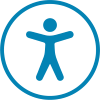Event Accessibility
Whether you are planning to host a small workshop, departmental program, or a large town hall in-person or virtually, these events must be accessible to all CSULB employees and students if the entire campus is invited to attend. Accessibility is key in providing inclusive excellence and must be the first thing that is addressed during the planning stage. Sponsoring departments are responsible for the costs associated with disability-related access, including, but not limited to, ASL Interpreting and Real-Time Captioning; these services are part of the overall expense of hosting a University event. Below are disability-related accessibility requirements for any events being hosted:
Departments and Divisions may be sponsoring educational workshops and programs that are open to all students and employees. Please note that CSULB University, Division or Campus-wide programs must be accessible to everyone, including our Deaf/hard of hearing/hearing impaired (DHH) faculty, staff, and students. We have disability accessibility requirements for anyone hosting programs open to all students and employees in the University, or Division, or Campus. Please include the below accessibility language onto event/programming materials as it relates to employee participation:
"If you are needing a reasonable accommodation based on a disability or medical restriction to access this program, please contact Staff Human Resources (StaffHR-Accommodations@csulb.edu) for employees as soon as possible so we can assist you prior to the program."
If hosting an event for students, your program advertisements must state:

To request disability-related accommodations, complete the Bob Murphy Access Center Event Request Form.
If utilizing the inclusive accessibility symbol only, it must be hyperlinked directly to the BMAC Event Request Form. BMAC will contact the host department should there be a confirmed accommodation request and coordinate accessibility support. Sponsoring departments are responsible for the costs associated with disability access as these are part of the overall expense of a University event.
- Accessibility statement - make sure that your event marketing materials contain the applicable student/employee accessibility statement for individuals to request accommodations.
- Physical Accessibility – ensure the location is physically accessible via elevator, ramps, accessible pathways, etc. The CSULB Interactive Map may be utilized to view campus accessibility routes.
- Technology - if utilizing an interactive platform, contact the vendor prior to planning and utilization to ensure that the technology/software/hardware you are using for the event is accessible.
- Presentation platform accessibility:
- Announce messages on the Zoom chat box. Reading aloud messages will help participants who are visually unable to participate (visually impaired or join meeting by phone) follow along during the meeting.
- Email attachments and links before the scheduled Zoom meeting. By doing so, screen reader users will be able to follow along during the presentation without interruptions. Emailing the agenda and document files beforehand will also benefit participants who may forget to save attachments or links that are provided in the chat box.
- Announce visual cues during the presentation. Visual cues during screen sharing need to be described because the screen share feature is inaccessible to Blind or Visually Impaired users who utilize screen readers. Describe what is on the screen and what actions you are taking.
- It is recommended to have the speaker use headphones whenever possible to increase the audio quality.
- Mute participants to avoid any unnecessary background noise that can be distracting.
- Ask participants to state their name when they speak, so the captioner knows who is speaking.
- Document Accessibility - Built-in accessibility checkers with PDF and word documents can be utilized to ensure document accessibility. If you require assistance, contact your campus accessibility service.
- Image Accessibility - Images embedded in documents, websites, emails, or social media posts require alternative text. Alternative text is also known as "alt text," and is a brief 8 to 120 character description of the information or context the image is conveying. Alternative text can be provided for both Microsoft Office documents as well as PDF by accessing the following guide. If you require assistance, contact your campus accessibility service.
- Auto Captioning should only be used for live events where there are no confirmed DHH requests. It is recommended to be used more so as a notetaking tool to assist with universal design and inclusive excellence as well as to support individuals who are hard of hearing on a case-by-case basis.
- Video Captioning must be provided for any pre-recorded videos.
- Departments must caption any material of their own that is pre-recorded.
- Tutorials on how to do so can be found on the ATI website regarding audio/video accessibility.
- If showing feature-length films at events, please ensure that closed captions are readily available.
- View the CSU Accessible Technology Initiative Captioning Prioritization guide for additional information.
- Communication Access Realtime Translation (CART) Providers and American Sign Language (ASL) Interpreters should be utilized in the following instances:
- Confirmed requests for CART Providers and/or ASL Interpreters.
- Events with more than 200 confirmed participants or that are open to the entire University
- Official video/audio addresses on important topics such as President remarks, updates on COVID, campus messages, etc.
- ASL Interpreters must be “in-frame” for any health and safety campus-wide updates regarding COVID-19.
- Additionally, keep in mind:
- If hosting an event on Zoom, the host must update to the latest version of Zoom to allow spotlighting of more than one individual (e.g. speaker and ASL interpreters) as well as enable their Zoom settings have captioning support.
- Realtime captioning for Deaf and Hard of Hearing individuals must be supported by BMAC CART providers.
- The University needs at least 2 weeks advance notice for a program as we must secure up to two interpreters for each program to ensure they are accessible.
- CSULB-wide programs must be accessible to all students and employees.





